Yunbin He's group @ SMSE, HUBU
Welcome you to join us!
Open positions always available for Ph. D students and postdoctoral fellows
Our research group consists of 7 faculties including 2 professors, 3 associate professors, 2 lecturers, and more than 20 graduate students. Our main research fields include wide bandgap semiconductor thin films and ultraviolet optoelectronic devices, surface physics and chemistry of oxides, nanomaterials and nanotechnology, ferroelectric photovoltaics and dielectric energy storage. Our group has been granted more than 10 projects from National Natural Science Foundation of China and key projects from the Ministry of Education of China and Hubei Province. Our research has so far resulted in about 100 scientific articles published in high-profile journals including Nature Mater., Phys. Rev. Lett., Angew. Chem. Int. Ed., J. Am. Chem. Soc., Anal. Chem., J . Power Sources, Adv. electron. Mater. Appl. Phys. Lett., and so on. More than 20 invention patents have been applied with 10 patents awarded.

Brief introduction to the group members
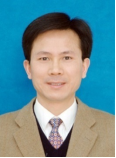 Yunbin He obtained his B.S. degree in Physics and M.S. degree in Materials Science both from Hubei University, China, in 1994 and 1997, respectively. He received his Ph.D. degree (supervised by Professor Bruno K. Meyer) in Materials Physics from the First Physics Institute of Justus-Liebig University Giessen, Germany, in 2003. From February 2004 to January 2007, he worked with Professor Herbert Over as a Postdoc at the Physical Chemistry Institute of Justus-Liebig University Giessen, and later with Dr. Andreas Stierle at the Max-Planck-Institute for Metals Research, Stuttgart, Germany, on oxidization of nanomaterials. Afterwards, he joined Professor Ulrike Diebold’s surface science group at Tulane University, New Orleans, USA, working on oxides surface. Since January 2009, he has been working as a Chutian Scholar Chair Professor at School of Materials Science and Engineering, Hubei University, China.
Yunbin He obtained his B.S. degree in Physics and M.S. degree in Materials Science both from Hubei University, China, in 1994 and 1997, respectively. He received his Ph.D. degree (supervised by Professor Bruno K. Meyer) in Materials Physics from the First Physics Institute of Justus-Liebig University Giessen, Germany, in 2003. From February 2004 to January 2007, he worked with Professor Herbert Over as a Postdoc at the Physical Chemistry Institute of Justus-Liebig University Giessen, and later with Dr. Andreas Stierle at the Max-Planck-Institute for Metals Research, Stuttgart, Germany, on oxidization of nanomaterials. Afterwards, he joined Professor Ulrike Diebold’s surface science group at Tulane University, New Orleans, USA, working on oxides surface. Since January 2009, he has been working as a Chutian Scholar Chair Professor at School of Materials Science and Engineering, Hubei University, China.
Prof. He's main research areas include surface and interface science, materials physics and chemistry, and nanoscience and nanotechnology. He has so far published more than 130 scientific articles, among which over 100 papers are in SCI journals, including one in Nat. Mater. and one in Phys. Rev. Lett. His papers have been cited for over 1700 times by SCI to date, with SCI-H index of 24. He has applied for more than 20 Chinese Invention Patents, with 10 patents awarded. He has been granted 4 projects from the National Natural Science Foundation of China and several key projects from the Ministry of Education of China and Hubei Province.
Prof. He is a member of the American Physical Society (APS), the European Materials Research Society (EMRS), Chinese Materials Research Society (CMRS), and Senior Experts Association of Hubei Province. He currently serves as an Editorial Board member for a Chinese scientific journal, Surface Technology. He is also a frequently invited reviewer for over 20 international journals.
Email: ybhe@hubu.edu.cn
 Gang Chang obtained his B.S. degree and M.S. degree in Chemistry both from Wuhan University, China, in 1999 and 2012, respectively. He received his Ph.D. degree (supervised by Prof. Hirao and Prof. Oyama) in Materials Chemistry from Kyoto University, Japan, in 2006. From Oct. 2006 to Jul. 2010, he worked as a Postdoc researcher on controllable preparation of Au Nanomaterials and their applications at Kyoto University, Osaka Institute of Technology and National Institute of Advanced Industrial Science and Technology (AIST), Japan, respectively. From 2010 to 2016, he had been working as associate Professor at School of Materials Science and Engineering, Hubei University, China. In June 2016, he was promoted to full professor in Hubei University.
Gang Chang obtained his B.S. degree and M.S. degree in Chemistry both from Wuhan University, China, in 1999 and 2012, respectively. He received his Ph.D. degree (supervised by Prof. Hirao and Prof. Oyama) in Materials Chemistry from Kyoto University, Japan, in 2006. From Oct. 2006 to Jul. 2010, he worked as a Postdoc researcher on controllable preparation of Au Nanomaterials and their applications at Kyoto University, Osaka Institute of Technology and National Institute of Advanced Industrial Science and Technology (AIST), Japan, respectively. From 2010 to 2016, he had been working as associate Professor at School of Materials Science and Engineering, Hubei University, China. In June 2016, he was promoted to full professor in Hubei University.
Prof. Chang’s main research area is focused on nanoscience and nanotechnology, especially the preparation of metal and two dimensional materials nanocomposites and their application in fuel cell and biosensor with high sensitivity. He has so far published more than 60 scientific articles, among which over 50 papers are in SCI journals, including Analytical Chemistry, ACS Applied Materials & Interfaces, Acta materialia and Biosensor &Bioelectronics. His papers have been cited for over 700 times by SCI to date. He has applied for more than 10 Chinese Invention Patents, with 5 patents awarded. He has been granted 2 projects from the National Natural Science Foundation of China and 6 key projects from the Ministry of Education of China and Hubei Province. He was elected in the “Chu-Tian Scholar Program” from Hubei Province and "Outstanding Talents Program" in Hubei University. Prof. Chang is a member of the American Chemical Society (ACS) and Chinese Chemical Society (CCS).
Email: changgang@hubu.edu.cn
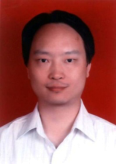 Mingkai Li obtained B.S. degree in Applied Physics in 1998 and Ph. D degree in Condensed Matter Physics in 2004 both from Wuhan University. From November 2004 to June 2011, he worked in Quantum-functional Research Center of Dongguk University in Korea as postdoc and research professor. Since July 2011, he joined in School of Materials Science and Engineering as associate professor in Hubei University. From September 2016 to August 2017, he visited Department of Physics and Astronomy in Uppsala University, Sweden, supported by China Scholarship Council.
Mingkai Li obtained B.S. degree in Applied Physics in 1998 and Ph. D degree in Condensed Matter Physics in 2004 both from Wuhan University. From November 2004 to June 2011, he worked in Quantum-functional Research Center of Dongguk University in Korea as postdoc and research professor. Since July 2011, he joined in School of Materials Science and Engineering as associate professor in Hubei University. From September 2016 to August 2017, he visited Department of Physics and Astronomy in Uppsala University, Sweden, supported by China Scholarship Council.
Until now, Dr. Mingkai Li has been granted several projects including the National Natural Science Foundation of China and Natural Science Foundation of Hubei Province and Doctoral Program of Higher Education of China, etc. He published about 60 SCI research articles, including several in Physical Review B and Applied Physics Letters, and applied 10 patents.
His main research areas include wide band gap semiconductors, novel materials discovery by the first-principles calculations.
Email: mkli@hubu.edu.cn
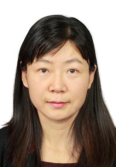 Yinmei Lu obtained her B.S. degree in Physics from Hubei University, China, in 1996. She received her Diplom degree (equivalent to M. S. degree) in Physics from the First Physics Institute of Justus-Liebig University of Giessen, Germany, in April 2006. After the Diplom study she has worked in Siemens Power Generator AG in Erfurt for a few months. From January 2009 until April 2012, she has worked as a lab technician at School of Materials Science and Engineering, Hubei University, China. From May 2012 until December 2015, she has worked as Ph.D. student (supervised by Professor Bruno K. Meyer and Professor Peter J. Klar) in Materials Physics at the First Physics Institute of Justus-Liebig University of Giessen, Germany, and obtained her Ph.D. degree in December 2015. Since Jan. 2016, she has been working as a lecturer in Hubei University, China.
Yinmei Lu obtained her B.S. degree in Physics from Hubei University, China, in 1996. She received her Diplom degree (equivalent to M. S. degree) in Physics from the First Physics Institute of Justus-Liebig University of Giessen, Germany, in April 2006. After the Diplom study she has worked in Siemens Power Generator AG in Erfurt for a few months. From January 2009 until April 2012, she has worked as a lab technician at School of Materials Science and Engineering, Hubei University, China. From May 2012 until December 2015, she has worked as Ph.D. student (supervised by Professor Bruno K. Meyer and Professor Peter J. Klar) in Materials Physics at the First Physics Institute of Justus-Liebig University of Giessen, Germany, and obtained her Ph.D. degree in December 2015. Since Jan. 2016, she has been working as a lecturer in Hubei University, China.
Dr. Lu’s main research area is materials physics. She is good at Sputter deposition, CVD (chemical vapor deposition), PLD (pulsed laser deposition), and has significant hands-on experience in SEM (scanning electron microscopy), XRD, optical transmission, Raman and Hall-effect measurements. She has so far published more than 20 scientific articles, among which 17 papers are in SCI journals.
Email: yinmei_lu@hubu.edu.cn
 Pai Li obtained her B.S. degree in Applied Physics from HuaZhong University of Science and Technology, China, in 2004. She received her Ph.D. degree (supervised by Professor Bruno K. Meyer) in Material Physics and Chemistry from HuaZhong University of Science and Technology, in 2009. From September 2009 to June 2011, she worked with Professor CeWen Nan as a Postdoc at the School of Materials Science and Engineering of Tsinghua University, working on multiferroic materials. Since July 2011, she has been working at School of Materials Science and Engineering, Hubei University, China.
Pai Li obtained her B.S. degree in Applied Physics from HuaZhong University of Science and Technology, China, in 2004. She received her Ph.D. degree (supervised by Professor Bruno K. Meyer) in Material Physics and Chemistry from HuaZhong University of Science and Technology, in 2009. From September 2009 to June 2011, she worked with Professor CeWen Nan as a Postdoc at the School of Materials Science and Engineering of Tsinghua University, working on multiferroic materials. Since July 2011, she has been working at School of Materials Science and Engineering, Hubei University, China.
Pai Li's main research areas include multiferroic materials and devices, surface and interface science, materials physics and chemistry. She is able to prepare semiconductor inorganic nonmetal oxide film and photocatalytic composite materials, and she could skillfully use XRD, SEM, TEM, EDX, XPS and STM and other testing methods to structure characterization and performance testing of materials. As the main research backbone, she has so far participated in a number of research projects and published more than 20 SCI papers in domestic and foreign academic journals, among which 7 papers were published as the first or correspondent author.
Email: paili@hubu.edu.cn
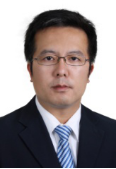 Qingfeng Zhang obtained his B.S. degree in Physics from Henan University, China, in 2002. He received his M.S. degree and Ph.D. degree in Condensed Matter Physics (supervised by Professor Yihua Gao) and Microelectronics and Solid State Electronics (supervised by Professor Shenglin Jiang) from Huazhong University of Science and Technology, China, in 2008 and 2012, respectively. From March 2012 to February 2014, he worked with Professor Tongqing Yang as a Postdoc in Tongji University, on electric field induced strain and energy storage properties of antiferroelectric materials. Afterwards, he joined Professor Jinsong Huang’s solar-cell group at University of Nebraska Lincoln, Lincoln, USA, working on ferroelectric photovoltaic effect. Since 2016, he has been working at School of Materials Science and Engineering, Hubei University, China and became an associate professor in 2017.
Qingfeng Zhang obtained his B.S. degree in Physics from Henan University, China, in 2002. He received his M.S. degree and Ph.D. degree in Condensed Matter Physics (supervised by Professor Yihua Gao) and Microelectronics and Solid State Electronics (supervised by Professor Shenglin Jiang) from Huazhong University of Science and Technology, China, in 2008 and 2012, respectively. From March 2012 to February 2014, he worked with Professor Tongqing Yang as a Postdoc in Tongji University, on electric field induced strain and energy storage properties of antiferroelectric materials. Afterwards, he joined Professor Jinsong Huang’s solar-cell group at University of Nebraska Lincoln, Lincoln, USA, working on ferroelectric photovoltaic effect. Since 2016, he has been working at School of Materials Science and Engineering, Hubei University, China and became an associate professor in 2017.
Prof. Zhang's main research areas include pyroelectric materials and infrared detectors, energy storage materials and capacitors, and inorganic perovskite solar cells. He has so far published nearly 30 papers in SCI journals including Appl. Phys. Lett. and J. Am. Ceram. Soc. as the first or corresponding author. He has been granted 1 projects from the National Natural Science Foundation of China and 3 post-doctoral projects. He was elected in the “Chu-Tian Scholar Program” from Hubei Province in 2016.
Email: zhangqingfeng@hubu.edu.cn
 Junnian Chen received her BS degree in Applied Chemistry from Huazhong Agricultural University in 2009, and PhD in Inorganic Chemistry from Wuhan University under the supervision of Prof. Tianyou Peng in 2014. Afterwards she joined in Huazhong University of Science and Technology as a postdoctoral fellow in Prof. Tianyou Zhai’s group for two years. Dr Chen then joined the School of Materials Science and Engineering of Hubei University in 2017. Her current research interests include the controlled synthesis and exploration of fundamental physical properties of two dimensional inorganic and organic hybrid perovskites, as well as their promising applications in optoelectronics. She has so far published 19 scientific articles in SCI journals, including two first-authored articles in Angew. Chem. Int. Ed. Her papers have been cited for over 500 times by SCI up to date, with SCI-H index of 13.
Junnian Chen received her BS degree in Applied Chemistry from Huazhong Agricultural University in 2009, and PhD in Inorganic Chemistry from Wuhan University under the supervision of Prof. Tianyou Peng in 2014. Afterwards she joined in Huazhong University of Science and Technology as a postdoctoral fellow in Prof. Tianyou Zhai’s group for two years. Dr Chen then joined the School of Materials Science and Engineering of Hubei University in 2017. Her current research interests include the controlled synthesis and exploration of fundamental physical properties of two dimensional inorganic and organic hybrid perovskites, as well as their promising applications in optoelectronics. She has so far published 19 scientific articles in SCI journals, including two first-authored articles in Angew. Chem. Int. Ed. Her papers have been cited for over 500 times by SCI up to date, with SCI-H index of 13.
Email: chenjunnian910@hubu.edu.cn
Introduction to main research fields
I. Semiconductor thin films and devices
In this direction, we mainly study wide band gap semiconductors and photoelectric detection devices. The ultimate goal is to prepare a photoelectric detector with low cost, simple preparation process and response in the sun blind zone. The wide band gap semiconductors of interest includes ZnO-based ternary and quaternary alloys, such as ZnOS, BeZnOS, MgZnOS, CdZnOS, BeMgZnO, etc, SnO2, and Ga2O3. The researches involve epitaxial film growth, properties characterization, device fabrication, and theoretical investigations.
We use pulsed laser deposition (PLD) method to grow the epitaxial films with various compositions under different growth conditions. Multiple techniques such as HRXRD, XPS, AFM, SEM, UV-Vis-IR spectroscopy, PL, etc, are employed to characterize the structural, compositional, morphological, and optical properties of the films. Eventually, electrodes are evaporated on the films to fabricate optoelectronic devices. The devices that are of our main interest include flexible light emitting devices such as ACEL panels and fibers based on ZnS phosphor and Ag nanowire-electrodes, and ultraviolet solar-blind photodetectors. With simple blade-coating technique, we have achieved ACEL panels, which exhibit high brightness, excellent flexibility and mechanical stability. Utilizing simple dip-coating technique, we further succeeded in producing long and flexible ACEL wires with excellent wear-ability and weave-ability demonstrating high potential for future production of functional ACEL cloths. We perform the first-principles calculations based on density functional theory (DFT) to analyze the structural, electronic, and thermodynamic properties of isovalent anion and cation substituted ZnO-based ternary alloys as well as the anion and cation co-substituted ZnO-based quaternary alloys, complementing and guiding our experimental work.

Yunbin He*, Liangheng Wang, Lei Zhang, Mingkai Li, Xunzhong Shang, Yanyan Fang, Changqing Chen,Solubility limits and phase structures in epitaxial ZnOS alloy films grown by pulsed laser deposition, J. Alloy. Compd. 534 (2012) 81–85.
Yunbin He*, Lei Zhang, Liangheng Wang, Mingkai Li, Xunzhong Shang, Xiong Liu, Yinmei Lu, and Bruno K. Meyer, Structural and optical properties of single-phase ZnO1-xSx alloy films epitaxially grown by pulsed laser deposition, J. Alloy. Compd., 587 (2014) 369–373.
Mingkai Li, Yali Ding, Panke Liu, Long Fang, Lei Li, Wei Zhang, Lei Zhang, Yunbin He*, The S concentration dependence of lattice parameters and optical band gap of a-plane ZnOS grown epitaxially on r-plane sapphire, J. Alloy. Compd. 630 (2015) 106–109.
Lilan Zheng, Yinyin Lin, Lei Li, Guojin Liang, Mingkai Li*, Pai Li, Yunbin He*, Structural properties and enhanced bandgap tunability of quaternary CdZnOS epitaxial films grown by pulsed laser deposition, J. Alloy. Compd. 650 (2015)748-752.
Yunbin He*, Hailing Cheng, Jiali Tai, Lei Li, Lei Zhang, Mingkai Li*, Yinmei Lu, Wei Zhang, and Bruno K. Meyer, Single-phase quaternary MgxZn1-xO1-ySy alloy thin films grown by pulsed laser deposition, J. Appl. Phys. 117 (2015) 065301.
Mi Zhang, Maji Xu, Mingkai Li, Qingfeng Zhang, Yinmei Lu*, Jingwen Chen, Ming Li, Jiangnan Dai, Changqing Chen, and Yunbin He*, SnO2 epitaxial films with varying thickness on c-sapphire: structure evolution and optical band gap modulation, Appl. Surf. Sci., 423 (2017) 611–618.
Wuzhong Zhang, Maji Xu, Mi Zhang, Hailing Cheng, Mingkai Li, Qingfeng Zhang, Yinmei Lu*, Jingwen Chen, Changqing Chen, and Yunbin He*, Pulsed laser deposited BexZn1-xO1-ySy quaternary alloy films: structure, composition, and band gap bowing, Appl. Surf. Sci., 433 (2018) 674–679.


Mingkai Li†, Minghai Luo†, Jiakun Zhu, Debing Long, Liangshuang Miao, Yunbin He*, First-principles calculations of the phase equilibrium of BexZn1-xO alloys, J. Appl. Phys. 121 (2017) 205101.
Mingkai Li, Debing Long, Rajeev Ahuja*, and Yunbin He*, Magnetic order and phase diagram of magnetic alloy system: MgxNi1–xO alloy, Phys. Status Solidi B, 254 (2017) 1700085.
Jiakun Zhu, Minghai Luo, Mingkai Li*,Yunbin He*,First-principles calculations of the thermodynamics of wurtzite and zincblende ZnO1-xSx alloys, Physica B: Physics of Condensed Matter, 520 (2017) 1–6.
Luo Ming-Hai, Li Ming-Kai, Zhu Jia-Kun, He Yun-Bin*, First-principles study on thermodynamic properties of CdxZn1-xO alloys, Acta Phys. Sin. 65 (2016) 157303.

Guojin Liang, Ming Yi, Haibo Hu*, Ke Ding, Lei Wang, Haibo Zeng, Jiang Tang, Lei Liao, Cewen Nan, Yunbin He*, and Changhui Ye*, Coaxial-Structured Weavable and Wearable Electroluminescent Fibers, Adv. Electron. Mater., 3 (2017) 201700401.
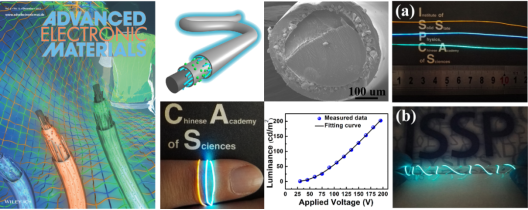
Guojin Liang, Haibo Hu*, Lei Liao, Yunbin He*, and Changhui Ye, Highly flexible and bright electroluminescent devices based on Ag nanowire electrodes and top-emission structure, Adv. Electron. Mater., 3 (2017) 201600535.
II. Surface physics and chemistry of oxides
In this field we have mainly studied the oxidation of single-crystal transition metals surfaces, the clean and water-adsorbed TiO2 anatase (101) and rutile (011)-(2x1) surfaces by UHV surface analysis techniques like STM, LEED, XPS, AES, TPD, etc.
Future work to be done includes the growth and characterization of high-quality VO2 epitaxial films, water adsorption on ZnO (11-20) and (10-10) surfaces, methanol adsorption on TiO2 rutile (110), anatase (101), and (001) surfaces.
TiO2: We have studied with STM the atomic structures of pristine and reduced anatase TiO2 (101) surfaces and water adsorption on these surfaces, which establishes the foundation for understanding the microscopic mechanism and photocatalytic decomposition of water on the surface of TiO2 at molecular level. We have found that a reduced anatase (101) crystal shows isolated as well as ordered intrinsic subsurface defects in STM, consistent with density functional theory (DFT) calculations which predict that O vacancies at subsurface and bulk sites are significantly more stable than on the surface.


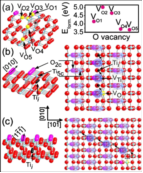
Yunbin He, Olga Dulub, Hongzhi Cheng, Annabella Selloni, and Ulrike Diebold*, Evidence for the Predominance of Subsurface Defects on Reduced Anatase TiO2 (101), Phys. Rev. Lett. 102 (2009) 106105.
Yunbin He, Daniel Langsdorf, Lei Li, and Herbert Over*, Versatile Model System for Studying Processes Ranging from Heterogeneous to Photocatalysis: Epitaxial RuO2(110) on TiO2(110), J. Phys. Chem. C. 119 (2015) 2692–2702.
We have reported that the electronic changes that are imparted by such an adsorbed water monomer to the anatase (101) surface lead to repulsive/attractive intermolecular interactions along/across rows. The resulting changes in the binding energy and the dynamical behavior of adsorbed water explain the experimentally observed tendency for the ordering of molecules on anatase (101).
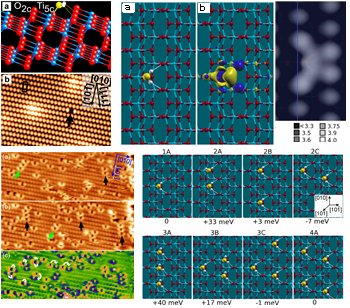
Yunbin He, Antonio Tilocca, Olga Dulub, Annabella Selloni, and Ulrike Diebold*, Local ordering and electronic signatures of submonolayer water on anatase TiO2(101), Nature Mater. 8(2009) 585.
Yunbin He, Wei-Kun Li, Xue-qing Gong, Olga Dulub, Annabella Selloni, and Ulrike Diebold*, Nucleation and growth of 1D water clusters on rutile TiO2(011)-2x1, J. Phys. Chem. C 113 (2009) 10329.
VO2: One of our future work will focus on a comprehensive study of the relationship between metal-insulator transition (MIT) and structural phase transition (SPT) of atomically smooth VO2 (110) thick film. In this work, we have already develop a post-annealing process to successfully obtain the atomically smooth VO2 (110) film on single-crystal TiO2 (110) substrate, which is confirmed by the in situ scanning tunneling microscopy (STM).
ZnO: At present, one of the work focuses on investigating the microscopic mechanism of the adsorption of water molecules on the non-polar ZnO (11-20) surfaces at molecular level. In this work, we have already found that the non-polar ZnO (11-20) surface is quite active in adsorbing water molecules at room temperature, which is confirmed by the in-situ STM, XPS and theoretical calculations.
III. Nanomaterials and Nanotechnology
Nanomaterials have attracted extensive interests for three decades due to their novel properties on electronics, photonics, catalysis, optical sensing, biomedical research compared with bulk materials. But there still exist huge challenges on controllable fabrication of nanoparticles, which could further tune their specific properties. Thus, in our research, we focused on studying controllable growth of metal or semiconductor nanoparticles on two dimensional materials (graphene, MOF, perovskite etc.) and their application on direct alcohol fuel cell (DAFC) and sensor devices.
Noble metal nanoparticles/graphene composites for fuel cell: We design and synthesis metal (alloy)/graphene nanocomposite as novel electrocatalyst for overcoming the main problems in DAFC such as high cost, poor poison resistance and so on. The high electrocatalytic activity of metal nanoparticles (Au, Pt, Pd and their alloy) could be combined with excellent merit of graphene such as excellent electron transfer and high specific area.
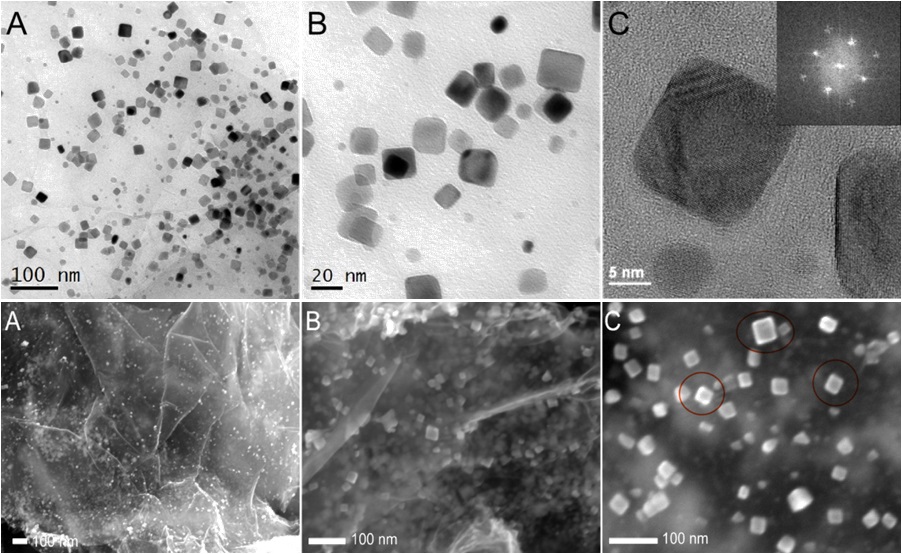
Kai Ji, Gang Chang*, Munetaka Oyama, Xunzhong Shang, Xiong Liu, Yunbin He*, Efficient and clean synthesis of graphene supported platinum nanoclusters and its application in direct methanol fuel cell, Electrochimica Acta 85 (2012) 84– 89.
Yuting Zhang, Honghui Shu, Gang Chang*, Kai Ji, Munetaka Oyama, Xiong Liu, Yunbin He*, Facile Synthesis of Palladium-graphene Nanocomposites and Their Catalysis for Electro-oxidation of Methanol and Ethanol, Electrochimica Acta, 109 (2013) 570–576.
Gang Chang, Honghui Shu, Kai Ji, Munetaka Oyama, Xiong Liu, and Yunbin He*, Gold Nanoparticles Directly Modified Glassy Carbon Electrode for Non-enzymatic Detection of Glucose, Appl. Surf. Sci., 288 (2014) 524– 529.
Honghui Shu, Leilei Cao, Gang Chang*, Hanping He, Yuting Zhang, Yunbin He*, Direct Electrodeposition of Gold Nanostructures on Glassy Carbon Electrode for Non-enzymatic Detection of Glucose, Electrochim. Acta, 132 (2014) 524–532.
Yuting Zhang, Gang Chang*, Honghui Shu, Munetaka Oyama, Xiong Liu, and Yunbin He*, Synthesis of Pt-Pd bimetallic Nanoparticles Anchored on Graphene for Highly Active Methanol Electro-oxidation, J. Power Sources, 262 (2014) 279-285.
Yuting Zhang, Qiwei Huang, Gang Chang*, Zaoli Zhang, Wenqing Wan, Honghui Shu, Tiantian Xia and Yunbin He*, Controllable Synthesis of Palladium Nanocubes/Reduced Graphene Oxide Composites and Their Enhanced Electrocatalytic Performance, J. Power Sources 280 (2015) 422-429.
Gang Chang*, Honghui Shu, Qiwei Huang, Munetaka Oyama, Kai Ji, Xiong Liu, and Yunbin He*, Synthesis of highly dispersed Pt nanoclusters anchored graphene composites and their application for non-enzymatic glucose sensing, Electrochim. Acta 157 (2015) 149–157.
Honghui Shu, Gang Chang∗, Jie Su, Leilei Cao, Qiwei Huang, Yuting Zhang, Tiantian Xia, Yunbin He*, Single-step electrochemical deposition of high performanceAu-graphene nanocomposites for nonenzymatic glucose sensing, Sensors and Actuators B 220 (2015) 331–339.
Hongmei Jia, Gang Chang*, Ming Lei, Hanping He, Xiong Liu, Honghui Shu, Tiantian Xia, Jie Su, Yunbin He*, Platinum nanoparticles decorated dendrite-like gold nanostructure on glassy carbon electrodes for enhancing electrocatalysis performance to glucose oxidation, Appl. Surf. Sci. 384 (2016) 58–64.
Hongmei Jia, Gang Chang, Honghui Shu, Maji Xu, Xunying Wang, Zaoli Zhang, Xiong Liu, Hanping He, Kai Wang, Ruizhi Zhu and Yunbin He*, Pt nanoparticles modified Au dendritic nanostructures: facile synthesis and enhanced electrocatalytic performance for methanol oxidation, Int. J. Hydrogen Energ., 42 (2017) 22100-22107.
Ribing Cao, Tiantian Xia, Ruizhi Zhu, Zhihua Liu, Jinming Guo, Gang Chang*, Zaoli Zhang, Xiong Liu, Yunbin He*, Novel synthesis of core-shell Au-Pt dendritic nanoparticles supported on carbon black for enhanced methanol electro-oxidation, Appl. Surf. Sci., 433 (2018) 840–846.
Nonenzymatic sensor devices: A new electrochemical solution transistor sensor was developed and fabricated by using graphene and their composite as channel or gate materials. The sensor devices have exhibited superior sensitivity and linear arrangement compared with the traditional amperometric sensor by using potentiostat.

IV. Ferroelectric photovoltaic and Dielectric Energy Storage
Clean, abundant and renewable solar energy is regarded as one of the most reliable energy resources to replace traditional fossil fuels. It can be harvested by conversion into electric energy with photovoltaic (PV) effects. In conventional semiconductor PV devices based on p-n junction or Schottky junction, the photogenerated electron-hole pairs are separated by the built-in potential that exists only in the space-charge region inside the p-n junction or Schottky junction. As a result, the Voc is always limited to below the band gap of the semiconductor materials. However, for ferroelectric PV effects, the photogenerated electron-hole pairs can be separated by the internal electric field arising from the remnant polarization of the ferroelectrics, and thus, the Voc is not limited by the band gap of the ferroelectric material. Besides, the internal electric field throughout the bulk region in ferroelectric is also very helpful for the separation of electron-hole pairs. All these provide a great potential for developing photovoltaic devices with high conversion efficiencies. However, FPV devices have by far remained an academic interest rather than having practical applications because of their very low Isc in the order of nA/cm2 ∼ μA/cm2. The low Isc is attributed primarily to the wide band gap characteristic of ferroelectric materials. In our work, we plan to develop ferroelectric materials with narrow band-gap and large remnant polarization and introduce it into the P-N junction of semiconductor solar cells to build thin-film solar cells involving ferroelectric depolarization and P-N junction built-in electric fields.
In recent years, fossil energy crisis,climate change and air pollution have inspired massive efforts to explore clean and renewable energy resources, such as solar, water, wind and thermal energy. This leads to a high demand for energy storage systems, such as batteries, fuel cells, electrochemical capacitors, and dielectric-based capacitors. Among these energy storage technologies, dielectric capacitors possess advantages such as high power density, fast charge/discharge rate (<1 µs), long lifetime and low cost. Thus, they may be used in hybrid electric vehicles, medical devices, mobile electronic devices and electrical weapon systems. However, these potential applications are severely limited by the low energy density of dielectric capacitors which is at least by an order of magnitude lower than those of batteries, fuel cells and electrochemical capacitors. Antiferroelectric materials typically exhibit large recoverable energy density because of their zero remnant polarization in idea case and high saturation polarization, as shown in the figure, and thus is a good choice for preparing capacitors with superior properties. In our work, we plan to develop lead-free antiferroelectric ceramic/thin film/thick film and ceramic-polymer based capacitors with high discharge energy density and energy conversion efficiency.

Qingfeng Zhang, Fang Xu, Maji Xu, Lei Li, Yinmei Lu, Mingkai Li, Pai Li, Ming Li, Gang Chang, Yunbin He*, Lead-free perovskite ferroelectric thin films with narrow direct band gap suitable for solar cell applications, Mater. Res. Bull., 95c (2017) 56-60.
Qingfeng Zhang, Yu Dan, Jian Chen, Yinmei Lu, Tongqing Yang, Xi Yao, Yunbin He*, Effects of composition and temperature on energy storage properties of (Pb,La)(Zr,Sn,Ti)O3 antiferroelectric ceramics, Ceram. Int., 43 (2017) 11428–11432.
Qingfeng Zhang, Fang Xu, Ronghuizi Yang, Yinmei Lu, Pai Li, Xunzhong Shang, Taosheng Zhou, Yunbin He*, Suppressed tanδ and enhanced Qm in KCT and Ni2O3 co-modified [(K0.43Na0.57)0.94Li0.06][(Nb0.94Sb0.06)0.95Ta0.05O3 lead-free piezoelectric ceramics, Ceram. Int. 43 (2017) 2537–2540.
Qingfeng Zhang, Huifen Tong, Jian Chen, Yinmei Lu, Tongqing Yang, Xi Yao, and Yunbin He*, High recoverable energy density over a wide temperature range in Sr modified (Pb,La)(Zr,Sn,Ti)O3 antiferroelectric ceramics with orthorhombic phase, Appl. Phys. Lett., 109 (2016) 262901.
Qingfeng Zhang, Jian Chen, Yinmei Lu, Tongqing Yang, Xi Yao, and Yunbin He*, (Pb,Sm)(Zr,Sn,Ti)O3 Multifunctional Ceramics with Large Electric-Field-Induced Strain and High-Energy Storage Density, J. Am. Ceram. Soc. 99 [12] (2016) 3853–3856.
Jinming Guo, Fang Xu, Xunzhong Shang, Yinmei Lu, Pai Li, Taosheng Zhou, Zaoli Zhang*, Yunbin He*, High-Performance Small-Amount Fe2O3 Doped (K,Na)NbO3-Based Lead-Free Piezoceramics with Irregular Phase Evolution, J. Am. Ceram. Soc. 99 (2016) 2341.
Recent publications of the group
1. Junnian Chen, Yaguang Wang, Lin Gan, Yunbin He, Huiqiao Li, and Tianyou Zhai*, Generalized Self-Doping Engineering towards Ultrathin and Large Sized Two-Dimensional Homologous Perovskite, Angew. Chem. Int. Ed. 56 (2017) 14893 –14897.
2. Jingwen Chen, Jun Zhang, Jiangnan Dai*, Feng Wu, Shuai Wang, Hanling Long, Renli Liang, Jin Xu, Changqing Chen, Zhiwu Tang, Yunbin He, Mingkai Li, and Zhechuan Feng, Strain dependent anisotropy in photoluminescence of heteroepitaxial nonpolar a-plane ZnO layers, Opt. Mater. Express 7 (2017) 3945.
3. Ribing Cao, Tiantian Xia, Ruizhi Zhu, Zhihua Liu, Jinming Guo, Gang Chang*, Zaoli Zhang, Xiong Liu, Yunbin He*, Novel synthesis of core-shell Au-Pt dendritic nanoparticles supported on carbon black for enhanced methanol electro-oxidation, Appl. Surf. Sci., 433 (2018) 840–846.
4. Wuzhong Zhang, Maji Xu, Mi Zhang, Hailing Cheng, Mingkai Li, Qingfeng Zhang, Yinmei Lu*, Jingwen Chen, Changqing Chen, and Yunbin He*, Pulsed laser deposited BexZn1-xO1-ySy quaternary alloy films: structure, composition, and band gap bowing, Appl. Surf. Sci., 433 (2018) 674–679.
5. Guojin Liang, Ming Yi, Haibo Hu*, Ke Ding, Lei Wang, Haibo Zeng, Jiang Tang, Lei Liao, Cewen Nan, Yunbin He*, and Changhui Ye*, Coaxial-Structured Weavable and Wearable Electroluminescent Fibers, Adv. Electron. Mater., 3 (2017) 201700401. (IF: 4.193) Front cover
6. Qingfeng Zhang, Fang Xu, Maji Xu, Lei Li, Yinmei Lu, Mingkai Li, Pai Li, Ming Li, Gang Chang, Yunbin He*, Lead-free perovskite ferroelectric thin films with narrow direct band gap suitable for solar cell applications, Mater. Res. Bull., 95c (2017) 56-60.
7. Zhenyu Tang, Ming Li*, Mengyao Song, Li Jiang, Jinhua Li, Yunbin He, Lixin Zhou*, Good conductivity of a single component polydiacetylene film, Organic Electronics 49 (2017) 174-178.
8. Mi Zhang, Maji Xu, Mingkai Li, Qingfeng Zhang, Yinmei Lu*, Jingwen Chen, Ming Li, Jiangnan Dai, Changqing Chen, and Yunbin He*, SnO2 epitaxial films with varying thickness on c-sapphire: structure evolution and optical band gap modulation, Appl. Surf. Sci., 423 (2017) 611–618. (IF: 3.387)
9. Bianca Eifert, Martin Becker, Christian T. Reindl, Marcel Giar, Lilan Zheng, Angelika Polity, Yunbin He*, Christian Heiliger*, and Peter J. Klar*, Raman studies of the intermediate tin-oxide phase, Phys. Rev. Mater., 1 (2017) 014602.
10. Qingfeng Zhang, Yu Dan, Jian Chen, Yinmei Lu, Tongqing Yang, Xi Yao, Yunbin He*, Effects of composition and temperature on energy storage properties of (Pb,La)(Zr,Sn,Ti)O3 antiferroelectric ceramics, Ceram. Int., 43 (2017) 11428–11432. (IF: 2.986)
11. Jiakun Zhu, Minghai Luo, Mingkai Li*,Yunbin He*,First-principles calculations of the thermodynamics of wurtzite and zincblende ZnO1-xSx alloys, Physica B: Physics of Condensed Matter, 520 (2017) 1–6. (IF: 1.386)
12. Mingkai Li, Debing Long, Rajeev Ahuja*, and Yunbin He*, Magnetic order and phase diagram of magnetic alloy system: MgxNi1–x O alloy, Phys. Status Solidi B, 254 (2017) 1700085. (IF: 1.674)
13. Mingkai Li†, Minghai Luo†, Jiakun Zhu, Debing Long, Liangshuang Miao, Yunbin He*, First-principles calculations of the phase equilibrium of BexZn1-xO alloys, J. Appl. Phys. 121 (2017) 205101. (IF: 2.068)
14. Ming Li*, Mengyao Song, Guitai Wu, Zhenyu Tang, Yunfeng Sun, Yunbin He*, Jinhua Li, Lei Li, Haoshuang Gu, Xiong Liu, Chuang Ma, Zefei Peng, David J. Lewis, A Free-standing and Self-healable Two-dimensional Supramolecular Material Based on Hydrogen Bonding: A Nano-wire Array with Sub-2 nm Resolution, Small, 13 (2017) 1604077. (IF: 8.643). Frontispiece
15. Debing Long, Mingkai Li*, Minghai Luo, Jiakun Zhu, Hui Yang, Zhongbing Huang, Rajeev Ahuja, Yunbin He*, Theoretical investigation on thermodynamic properties of ZnO1-xTex alloys, Mater. Res. Express, 4 (2017) 055901. (IF: 1.068)
16. Hongmei Jia, Gang Chang, Honghui Shu, Maji Xu, Xunying Wang, Zaoli Zhang, Xiong Liu, Hanping He, Kai Wang, Ruizhi Zhu and Yunbin He*, Pt nanoparticles modified Au dendritic nanostructures: facile synthesis and enhanced electrocatalytic performance for methanol oxidation, Int. J. Hydrogen Energ., 42 (2017) 22100-22107. (IF: 3.582)
17. Jingwen Chen, Jun Zhang, Jiangnan Dai*, Feng Wu, Shuai Wang, Cheng Chen, Hanling Long, Renli Liang, Chong Zhao, Changqing Chen*, Zhiwu Tang, Hailing Cheng, Yunbin He, and Mingkai Li, Electroluminescence from nonpolar n-ZnO/p-AlGaN heterojunction light-emitting diode on r-sapphire, J. Phys. D, 50 (2017) 115101. (IF: 2.588)
18. Guojin Liang, Haibo Hu*, Lei Liao, Yunbin He*, and Changhui Ye, Highly flexible and bright electroluminescent devices based on Ag nanowire electrodes and top-emission structure, Adv. Electron. Mater., 3 (2017) 201600535.(IF: 4.193)
19. Pai Li, Lei Li, Maji Xu, Qiang Chen, Yunbin He*, Enhanced photocatalytic property of BiFeO3/N-doped graphene composites and mechanism insight, Appl. Surf. Sci. 396 (2017) 879–887. (IF: 3.387)
20. Qingfeng Zhang, Fang Xu, Ronghuizi Yang, Yinmei Lu, Pai Li, Xunzhong Shang, Taosheng Zhou, Yunbin He*, Suppressed tanδ and enhanced Qm in KCT and Ni2O3 co-modified [(K0.43Na0.57)0.94Li0.06][(Nb0.94Sb0.06)0.95Ta0.05O3 lead-free piezoelectric ceramics, Ceram. Int. 43 (2017) 2537–2540. (IF: 2.986)
21. Qingfeng Zhang, Huifen Tong, Jian Chen, Yinmei Lu, Tongqing Yang, Xi Yao, and Yunbin He*, High recoverable energy density over a wide temperature range in Sr modified (Pb,La)(Zr,Sn,Ti)O3 antiferroelectric ceramics with orthorhombic phase, Appl. Phys. Lett., 109 (2016) 262901. (IF: 3.411)
22. Qingfeng Zhang, Jian Chen, Yinmei Lu, Tongqing Yang, Xi Yao, and Yunbin He*, (Pb,Sm)(Zr,Sn,Ti)O3 Multifunctional Ceramics with Large Electric-Field-Induced Strain and High-Energy Storage Density, J. Am. Ceram. Soc. 99 [12] (2016) 3853–3856 (IF: 2.841)
23. Hui Li, Zesong Wang, Ting Shi, Muhammad I. Yousaf, Mingkai Li, Bin Han, Vasiliy O. Pelenovich, Wei Wang, Yunbin He*, Dejun Fu*, Hierarchical film formation and structural characterization using MeV-ion beams, Surf. Coat. Technol., 306 (2016) 97-100. (IF: 2.589)
24. Benjamin Herd, Daniel Langsdorf, Christian Sack, Yun Bin He, and Herbert Over*, Oxygen - driven porous film formation of single crystalline Ru deposited on Au(111), Langmuir 32 (2016) 5291–5299. (IF: 3.833)
25. Hongmei Jia, Gang Chang*, Ming Lei, Hanping He, Xiong Liu, Honghui Shu, Tiantian Xia, Jie Su, Yunbin He*, Platinum nanoparticles decorated dendrite-like gold nanostructure on glassy carbon electrodes for enhancing electrocatalysis performance to glucose oxidation, Appl. Surf. Sci. 384 (2016) 58–64. (IF: 3.387)
26. Luo Ming-Hai, Li Ming-Kai, Zhu Jia-Kun, He Yun-Bin*, First-principles study on thermodynamic properties of CdxZn1-xO alloys, Acta Phys. Sin. 65 (2016) 157303. (IF: 0.624)
27. Jinming Guo, Fang Xu, Xunzhong Shang, Yinmei Lu, Pai Li, Taosheng Zhou, Zaoli Zhang*, Yunbin He*, High-Performance Small-Amount Fe2O3 Doped (K,Na)NbO3-Based Lead-Free Piezoceramics with Irregular Phase Evolution, J. Am. Ceram. Soc. 99 (2016) 2341. (IF: 2.841)
28. Pai Li, Qiang Chen, Yinyin Lin, Gang Chang, and Yunbin He*, Effects of crystallite structure and interface band alignment on the photocatalytic property of bismuth ferrite/(N-doped) graphene composites, J. Alloy. Compd. 672 (2016) 497-504. (IF: 3.133)
29. Luo Ming-Hai, Xu Ma-Ji, Huang Qi-Wei, Li Pai*, He Yun-Bin*, Research progress of metal-insulator phase transition mechanism in VO2, Acta Phys. Sin. 65 (2016) 047201. (IF: 0.624)
30. Qiang Sun, Liangliang Cai, Shiyong Wang, Roland Widmer, Huanxin Ju, Junfa Zhu, Lei Li, Yunbin He, Pascal Ruffieux, Roman Fasel, and Wei Xu*, Bottom-Up Synthesis of Metalated Carbyne, J. Am. Chem. Soc., 138 (2016) 1106. (IF: 13.858)
31. Jianyong Guo, Gang Chang, Wei Zhang, Xiong Liu, Yunbin He*, Facile synthesis of CuInS2 nanoparticles using different alcohol amines as solvent, Chem. Phys. Lett., 647 (2016) 51-54. (IF: 1.815)
32. Jie Su, Honghui Shu, Gang Chang*, Yuting Zhang, Yingying Zhou, Tiantian Xia, Hongmei Jia, Yunbin He*, The Development of New Nonenzymatic Glucose Biosensors Using Nanomaterials, Current Nanoscience, 11 (2015) 736-747. (IF:1.062)
33. Jiakun Zhu, Minghai Luo, Mingkai Li*, Yunbin He*, First-principles study of divalent IIA and transition IIB metals doping into Cu2O, Journal Wuhan University of Technology, Materials Science Edition, 30 (2015) 458-462.(IF:0.447)
34. Daniel Langsdorf, Benjamin Herd, Yunbin He, Herbert Over*, Oxidation-Induced Dispersion of Gold on Ru(0001): A Scanning Tunneling Microscopy Study, J. Phys. Chem. C. 119 (2015) 16046–16057 (IF: 4.536).
35. Lilan Zheng, Yinyin Lin, Lei Li, Guojin Liang, Mingkai Li*, Pai Li, Yunbin He*, Structural properties and enhanced bandgap tunability of quaternary CdZnOS epitaxial films grown by pulsed laser deposition, J. Alloy. Compd. 650 (2015)748-752.(IF:3.133)
36. Honghui SHU, Gang CHANG*, Zhiqiang WANG, Pai LI, Yuting ZHANG, and Yunbin He*, Pulse Laser Deposition Fabricating Gold Nanoclusters on a Glassy Carbon Surface for Nonenzymatic Glucose Sensing, ANALYTICAL SCIENCES, 31(2015) 609-616.(IF:1.228)
37. Honghui Shu, Gang Chang∗, Jie Su, Leilei Cao, Qiwei Huang, Yuting Zhang, Tiantian Xia, Yunbin He*, Single-step electrochemical deposition of high performanceAu-graphene nanocomposites for nonenzymatic glucose sensing, Sensors and Actuators B 220 (2015) 331–339.(IF:5.401)
38. PAN RUIKUN*, LIU PANKE, LI MINGKAI, TAO HAIZHENG, LI PAI and HE YUNBIN, Leakage current transport mechanisms of La0.67Sr0.33MnO3/BaTiO3 bilayer films grown on Nb:SrTiO3, Bull. Mater. Sci. 38 (2015) 725–729.(IF:0.899)
39. Vasiliy O. Pelenovich, Renzheng Xiao, Yong Liu, Panke Liu, Mingkai Li, Yunbing He, Dejun Fu*, Characterization of Bi2Se3:Fe epitaxial films grown by pulsed laser deposition, Thin Solid Films 577 (2015) 119–123.(IF:1.879)
40. Y. M. Lu, J. Jiang, C. Xia, B. Kramm, A. Polity, Y. B. He*, P. J. Klar and B. K. Meyer, The influence of oxygen flow rate on properties of SnO2 thin films grown epitaxially on c-sapphire by CVD, Thin Solid Films, 594 (2015) 270–276. (IF: 1.879)
41. Y. M. Lu, J. Jiang, M. Becker, B. Kramm, L. Chen, A. Polity, Y. B. He* , P. J. Klar, and B. K. Meyer, Polycrystalline SnO2 films grown by chemical vapor deposition on quartz glass, Vacuum 122 (2015) 347-352. (IF: 1.530)
42. Yunbin He*, Hailing Cheng, Jiali Tai, Lei Li, Lei Zhang, Mingkai Li*, Yinmei Lu, Wei Zhang, and Bruno K. Meyer, Single-phase quaternary MgxZn1-xO1-ySy alloy thin films grown by pulsed laser deposition, J. Appl. Phys. 117 (2015) 065301. (IF: 2.068)
43. Yunbin He, Daniel Langsdorf, Lei Li, and Herbert Over*, Versatile Model System for Studying Processes Ranging from Heterogeneous to Photocatalysis: Epitaxial RuO2(110) on TiO2(110), J. Phys. Chem. C. 119 (2015) 2692–2702 (IF: 4.536).
44. Gang Chang*, Honghui Shu, Qiwei Huang, Munetaka Oyama, Kai Ji, Xiong Liu, and Yunbin He*, Synthesis of highly dispersed Pt nanoclusters anchored graphene composites and their application for non-enzymatic glucose sensing, Electrochim. Acta 157 (2015) 149–157. (IF: 4.798)
45. Yuting Zhang, Qiwei Huang, Gang Chang*, Zaoli Zhang, Wenqing Wan, Honghui Shu, Tiantian Xia and Yunbin He*, Controllable Synthesis of Palladium Nanocubes/Reduced Graphene Oxide Composites and Their Enhanced Electrocatalytic Performance, J. Power Sources 280 (2015) 422-429. (IF: 6.395)
46. Mingkai Li, Yali Ding, Panke Liu, Long Fang, Lei Li, Wei Zhang, Lei Zhang, Yunbin He*, The S concentration dependence of lattice parameters and optical band gap of a-plane ZnOS grown epitaxially on r-plane sapphire, J. Alloy. Compd. 630 (2015) 106–109. (IF: 3.133).
47. Jun Zhang, Wu Tian, Feng Wu, Shichuang Sun, Shuai Wang, Jiangnan Dai*, Yanyan Fang, Zhihao Wu, Changqing Chen, Jiali Tai, Mingkai Li, Yunbin He, Optical properties of the nonpolar a-plane MgZnO films grown on a-GaN/r-sapphire templates by pulsed laser deposition, Opt. Mater Express, 4 (2014) 2346-2354, (IF: 2.591)
48. Lei Zhang, Lei Li, Liangheng Wang, Mingkai Li, Yinmei Lu, Bruno K. Meyer, Yunbin He*, Tuning the composition and optical band gap of pulsed laser deposited ZnO1-xSx alloy films by controlling the substrate temperature, J. Alloy. Compd., 617 (2014) 413–417. (IF: 3.133)
49. Tiantian Xia, Hanrui Shen, Gang Chang*, Yuting Zhang, Honghui Shu, Munetaka Oyama, and Yunbin He*, Facile and Rapid Synthesis of Ultrafine PtPd Bimetallic Nanoparticles and Their High Performance toward Methanol Electrooxidation, Journal of Nanomaterials, Volume 2014, Article ID 496249, 7 pages. (IF: 1.871)
50. Ruikun Pan*, Yunbin He, Mingkai Li, Pai Li, Panke Liu, Zhengcai Xia*, Resistive switching in epitaxial BaTiO3 films grown on Nb-doped SrTiO3 by PLD, Materials Science and Engineering B 188 (2014) 84–88. (IF: 2.552)
51. Lei Zhang, Liangheng Wang, Mingkai Li, Xunzhong Shang, Yunbin He*, Structural and Optical Properties of ZnO1-xSx Thin Films Grown by Pulse Laser Deposition on Glass Substrates, Materials Science Forum 787 (2014) 18-22. (EI)
52. Juan Xiong, Peng Guo, Yaxuan Cai, Bohumir Stradel, Jan. Brumek, Yunbin He, Haoshuang Gu*, Structural, magnetic and nanomechanical properties in Ni-doped AlN films, J. Alloy. Compd., 606 (2014) 55–60. (IF: 3.133)
53. Yuting Zhang, Gang Chang*, Honghui Shu, Munetaka Oyama, Xiong Liu, and Yunbin He*, Synthesis of Pt-Pd bimetallic Nanoparticles Anchored on Graphene for Highly Active Methanol Electro-oxidation, J. Power Sources, 262 (2014) 279-285. (IF: 6.395)
54. Honghui Shu, Leilei Cao, Gang Chang*, Hanping He, Yuting Zhang, Yunbin He*, Direct Electrodeposition of Gold Nanostructures on Glassy Carbon Electrode for Non-enzymatic Detection of Glucose, Electrochim. Acta, 132 (2014) 524–532. (IF: 4.798)
55. Xunzhong Shang, Lei Zhang, Jingang Fang, Mingkai Li, and Yunbin He*, Annealing and characterization of CuInS2 thin films prepared on sapphire substrates by pulsed laser deposition, Materials Research Innovations, 18 S4 (2014) 22-25 (IF: 0.830).
56. R. K. Pan, Z. C. Xia, Y. B. He, M. K. Li, P. Li, P. K. Liu, Leakage current analysis of La0.67Sr0.33MnO3/Nb:SrTiO3 p–n junctions, Appl. Phys. A, 116 (2014) 1885-1889. (IF: 1.455)
57. Jianyong Guo, Gang Chang*, Wei Zhang, Xiong Liu, Taosheng Zhou and Yunbin He*, Mild solution-based method for synthesizing wurtzite CuInS2 nanoplates at low temperature, Mater. Lett., 123 (2014) 169-171. (IF: 2.572)
58. Xunzhong Shang, Jinming Guo, Wanping Xiao, Yinmei Lu, Gang Chang, Taosheng Zhou, Yunbin He*, The Effects of Ta Substitution and K/Na Ratio Variation on the Microstructure and Properties of (K,Na)NbO3-Based Lead Free Piezoelectric Ceramics, J. ELECTRON. MATER., 43 (2014) 1424-1431. (IF: 1.579)
59. Lei Zhang, Jingang Fang, Mingkai Li, Xunzhong Shang, Tea Won Kang, Yunbin He*, Annealing effects on CuInS2 thin films grown by using pulsed laser deposition on glass substrates, Journal of Korean Physics Society, 64 (2014) 410-414. (IF: 0.467)
60. Xunzhong Shang, Zhiqiang Wang, Mingkai Li, Lei Zhang, Jingang Fang, Jiali Tai, Yunbin He*, A numerical simulation study of CuInS2 solar cells, Thin solid films, 550 (2014) 649–653. (IF: 1.879)
61. Yunbin He*, Lei Zhang, Liangheng Wang, Mingkai Li, Xunzhong Shang, Xiong Liu, Yinmei Lu, and Bruno K. Meyer, Structural and optical properties of single-phase ZnO1-xSx alloy films epitaxially grown by pulsed laser deposition, J. Alloy. Compd., 587 (2014) 369–373. (IF: 3.133)
62. Gang Chang, Honghui Shu, Kai Ji, Munetaka Oyama, Xiong Liu, and Yunbin He*, Gold Nanoparticles Directly Modified Glassy Carbon Electrode for Non-enzymatic Detection of Glucose, Appl. Surf. Sci., 288 (2014) 524– 529. (IF: 3.387)
63. Xiaoqin Chen, Cong Wei, Jun Xiao, Yun Xue, Xiangbin Zeng, Fujun Yang, Pai Li and Yunbin He, Room temperature multiferroic properties and magnetocapacitance effect of modified ferroelectric Bi4Ti3O12 ceramic, J. Phys. D. Appl. Phys. 46 (2013) 425001. (IF: 2.588)
64. Yuting Zhang, Honghui Shu, Gang Chang*, Kai Ji, Munetaka Oyama, Xiong Liu, Yunbin He*, Facile Synthesis of Palladium-graphene Nanocomposites and Their Catalysis for Electro-oxidation of Methanol and Ethanol, Electrochimica Acta, 109 (2013) 570–576. (IF: 4.798)
65. Xunzhong Shang, Heng Liu, Jinming Guo, Dan Jiang, Taosheng Zhou, Yunbin He*, Enhancing the properties of high-temperature BiScO3-PbTiO3 piezoceramics via Bi addition, Mater. Res. Bull., 48 (2013) 3072-3076. (IF: 2.446)
66. Mingmin Zhu, Xunzhong Shang, Gang Chang, Mingkai Li, Xiong Liu, Taosheng Zhou, Yunbin He*, Pulsed laser deposition of single-phase lead-free NKLNST thin films with K- and Na-excess targets, J. Alloy. Compd. 567 (2013) 97–101. (IF: 3.133)
67. Xunzhong Shang, Jingang Fang, Lei Zhang, Mingkai Li, Gang Chang, Pai Li, Yunbin He*, Pulsed laser deposition and characterization of epitaxial CuInS2 thin films on c-plane sapphire substrates, J. Alloy. Compd., 553 (2013) 282–285. (IF: 3.133)
68. H. Xiong, J.N. Dai*, Xiong Hui, Y.Y. Fang, W. Tian, D.X. Fu, C.Q. Chen*, Mingkai Li, Yunbin He, Effects of the AlN buffer layer thickness on the properties of ZnO films grown on c-sapphire substrate by pulsed laser deposition, J. Alloy. Compd. 554 (2013) 104–109. (IF: 3.133)
69. Yunbin He*, Liangheng Wang, Lei Zhang, Mingkai Li, Xunzhong Shang, Yanyan Fang, Changqing Chen,Solubility limits and phase structures in epitaxial ZnOS alloy films grown by pulsed laser deposition, J. Alloy. Compd. 534 (2012) 81–85. (IF: 3.133)
70. Kai Ji, Gang Chang*, Munetaka Oyama, Xunzhong Shang, Xiong Liu, Yunbin He*, Efficient and clean synthesis of graphene supported platinum nanoclusters and its application in direct methanol fuel cell, Electrochimica Acta 85 (2012) 84– 89. (IF: 4.798)
71. Ulrich Aschauer*, Yunbin He, Hongzhi Cheng, Shao-Chun Li, Ulrike Diebold, and Annabella Selloni, Influence of Subsurface Defects on the Surface Reactivity of TiO2: Water on Anatase (101), J. Phys. Chem. C 114 ( 2010) 1278. (IF: 4.536)
72. Yunbin He, Wei-Kun Li, Xue-qing Gong, Olga Dulub, Annabella Selloni, and Ulrike Diebold*, Nucleation and growth of 1D water clusters on rutile TiO2(011)-2x1, J. Phys. Chem. C 113 (2009) 10329. (IF: 4.536)
73. Yunbin He, Antonio Tilocca, Olga Dulub, Annabella Selloni, and Ulrike Diebold*, Local ordering and electronic signatures of submonolayer water on anatase TiO2(101), Nature Mater. 8(2009) 585. (IF: 39.737)
74. Yunbin He, Olga Dulub, Hongzhi Cheng, Annabella Selloni, and Ulrike Diebold*, Evidence for the Predominance of Subsurface Defects on Reduced Anatase TiO2 (101), Phys. Rev. Lett. 102 (2009) 106105. (IF: 8.462)
75. Xue-Qing Gong*, Navid Khorshidi, Andreas Stierle, Vedran Vonk, Claus Ellinger, Helmut Dosch, Hongzhi Cheng, Annabella Selloni, Yunbin He, Olga Dulub, Ulrike Diebold, The 2×1 Reconstruction of the Rutile TiO2 (011) Surface: a Combined Density Functional Theory, X-ray Diffraction, and Scanning Tunneling Microscopy Study. Surf. Sci. 603 (2009) 138. (IF: 2.062)
76. Erie H. Morales, Yunbin He, Mykola Vinnichenko, Bernard Delley, and Ulrike Diebold, Surface structure of Sn-doped In2O3(111) thin films by STM, New J. Phys., 10 (2008) 125030. (IF: 3.786)
77. Y. B. He, A. Stierle*, W. X. Li*, A. Farkas, N. Kasper, and H. Over*, Oxidation of Ir(111): from O-Ir-O trilayer to bulk oxide formation, J. Phys. Chem. C 112 (2008) 11946. (IF: 4.536).
78. P. Dudin, A. Barinov, L. Gregoratti, D. Scaini, Y. B. He, H. Over, and M. Kiskinova*, MgO-Supported Rhodium Particles and Films: Size, Morphology, and Reactivity, J. Phys. Chem. C 112 (2008) 9040. (IF: 4.536).
79. A. Goriachko, Y. B. He, H. Over*, Complex Growth of Nano-Au on BN Nanomeshes Supported by Ru(0001), J. Phys. Chem. C 112 (2008) 8147. (IF: 4.536).
80. H. Over*, Y.B. He, A. Farkas, G. Mellau, C. Korte, M. Knapp, M. Chandhok, M. Fang, Long-term Stability of Ru-based Protection Layers in EUV Lithography: A Surface Science Approach, J. Vac. Sci. Technol. B 25 (2007) 1123. (IF: 1.573)
81. Y. B. He, A. Goriachko, C. Korte, A. Farkas, G. Mellau, P. Dudin, L. Gregoriatti, A. Barinov, M. Kiskinova, A. Stierle, N. Kasper, S. Bajt, and H. Over*, Oxidation and Reduction of Ultrathin Nano-Crystalline Ru Films on Si(100): A Model System for Ru-capped EUVL Optics, J. Phys. Chem. C 111 (2007) 10988. (IF: 4.536).
82. Tao-Sheng Zhou, Rong-Xia Huang, Xun-Zhong Shang, Fei Peng, Jian-Yong Guo, Li-Ying Chai, Hao-Shuang Gu, Yun-Bin He, Lead-free In2O3-doped (Bi0.5Na0.5)0.93Ba0.07TiO3 ceramics synthesized by direct reaction sintering, Appl. Phys. Lett. 90 (2007) 182903. (IF: 3.411)
83. A. Goriachko, Y. B. He, M. Knapp, H. Over*, M. Corso, T. Brucker, S. Berner, J. Osterwalder, T. Greber*, Self-Assembly of a Hexagonal Boron Nitride Nanomesh on Ru(0001), Langmuir 23 (2007) 2928. (IF: 3.833)
84. Y. M. Lu, Y. B. He*, B. Yang, A. Polity, N. Volbers, C. Neumann, D. Hasselkamp, and B. K. Meyer, RF reactive sputter deposition and characterization of transparent CuAlO2 thin films, Phys. Stat. Sol. (c) 3 (2006) 2895.
85. Yunbin He*, Ari P. Seitsonen, and Herbert Over, Ultrathin Rh films on Ru(0001): oxidation in confinement, J. Chem. Phys. 124 (2006) 034706. (IF: 2.965)
86. Y. B. He, M. Knapp, E. Lundgren, and H. Over*, Ru(0001) model catalyst under oxidizing and reducing reaction conditions: In-situ high-pressure surface x-ray diffraction study, J. Phys. Chem. B 109 (2005) 21825. (IF: 3.177)
87. Yunbin He*, Ari P. Seitsonen, and Herbert Over, Irregular stacking sequence in the initial growth of ultrathin Rh films on Ru(0001), Phys. Rev. B 72 (2005) 075432. (IF: 3.836)
88. Bin Yang, Yunbin He, Angalika Polity, and Bruno K. Meyer, Structural, Optical and Electrical Properties of Transparent Conducting CuInO2 Thin Films Prepared by RF Sputtering, MRS Proceedings 865 (2005) 399.
89. Y. B. He*, T. Krämer, I. Österreicher, A. Polity, B. K. Meyer, M. Hardt, Post-growth treatment effects on properties of CuInS2 thin films deposited by RF reactive sputtering, Semicond. Sci. Tech. 20 (2005) 685–692. (IF: 2.305)
90. B.K. Meyer*, A. Polity, B. Farangis, Y.B. He, D. Hasselkamp, Th. Krämer, C. Wang, Structural properties and band gap bowing of ZnO1-xSx thin films deposited by reactive sputtering, Appl. Phys. Lett. 85 (2004) 4929-4931. (IF: 3.411)
91. Bruno K. Meyer*, Angelika Polity, Baker Farangis, Yunbin He, Dietmar Hasselkamp, Thorsten Krämer, Changzhong Wang, Ute Haboeck, and Axel Hoffmann, On the composition dependence of ZnO1-xSx, phys. stat. sol. (c) 1 (2004) 694–697.
92. Y. B. He*, A. Krost, J. Bläsing, W. Kriegseis, A. Polity, B. K. Meyer, C. Kisielowski, Quasi-epitaxial growth of thick CuInS2 films by RF reactive sputtering with a thin epilayer buffer, Thin Solid Films 451-452 (2004) 229-232. (IF: 1.879)
93. Y. B. He*, W. Kriegseis, B. K. Meyer, A. Polity, M. Serafin, Heteroepitaxial growth of CuInS2 thin films on sapphire by radio frequency reactive sputtering, Appl. Phys. Lett. 83 (2003) 1743-1745. (IF: 3.411)
94. Y. B. He*, W. Kriegseis, T. Krämer, A. Polity, M. Hardt, B. Szyszka, B. K. Meyer, Deposition of CuInS2 thin films by RF reactive sputtering with a ZnO:Al buffer layer, J. Phys. Chem. Solids 64 (2003) 2075-2079. (IF: 2.059)
95. Y. B. He*, T. Krämer, A. Polity, R. Gregor, W. Kriegseis, I. Österreicher, D. Hasselkamp, B. K. Meyer, Preparation and characterization of highly (112) oriented CuInS2 films deposited by a one-stage RF reactive sputtering process, Thin Solid Films 431-432 (2003) 231-236. (IF: 1.879)
96. Y. B. He*, T. Krämer, A. Polity, M. Hardt, B. K. Meyer, Influence of the preparation conditions on the properties of CuInS2 films deposited by one-stage RF reactive sputtering, Thin Solid Films 431-432 (2003) 126-130. (IF: 1.879)
97. Y. B. He*, T. Krämer, A. Polity, M. Hardt, B. K. Meyer, Post-growth treatments on CuInS2 thin films deposited by RF reactive sputtering, in: Advanced Nanomaterials and Nanodevices (IUMRS-ICEM 2002, Xi’an, China, 10-14 June 2002), 927-942.
98. Yunbin He*, I. Österreicher, T. Krämer, A. Polity, W. Kriegseis and B. K. Meyer, M. Hardt, Surface and structural characterization of CuInS2 thin films deposited by one-stage RF reactive sputtering, Int. J. Mod. Phys. B 16 (2002) 4380-4386. (IF: 0.736)
99. Yunbin He*, Wilhelm Kriegseis, Jürgen Bläsing, Angelika Polity, Thorsten Krämer, Dietmar Hasselkamp, Bruno K. Meyer, Martin Hardt and Alois Krost, (001)-Textured Cu2S Thin Films Deposited by RF Reactive Sputtering, Jpn. J. Appl. Phys. 41 (2002) 4630-4634. (1.384)
100. Yunbin He*, Thorsten Krämer, Ingo Österreicher, Angelika Polity, Ralf Gregor, Wilhelm Kriegseis, Dietmar Hasselkamp and Bruno K. Meyer, Highly (112)-Oriented CuInS2 Thin Films Deposited by a One-Stage RF Reactive Sputtering Process, Jpn. J. Appl. Phys. 41 (2002) L 484-L 486. (IF: 1.384)
101. Y. B. He*, A. Polity, H. R. Alves, I. Österreicher, W. Kriegseis, D. Pfisterer, B. K. Meyer, and M. Hardt, Structural and optical characterization of RF reactively sputtered CuInS2 thin films, Thin Solid Films 403-404 (2002) 62-65. (IF: 1.879)
102. Y. B. He*, A. Polity, R. Gregor, D. Pfisterer, I. Österreicher, D. Hasselkamp, B. K. Meyer, Characterization of RF reactively sputtered Cu-In-S thin films, Physica B 308-310 (2001) 1074-1077. (IF: 1.386)
103. Y. B. He*, A. Polity, I. Österreicher, D. Pfisterer, R. Gregor, B. K. Meyer, and M. Hardt, Hall effect and surface characterization of Cu2S and CuS films deposited by RF reactive sputtering, Physica B 308-310 (2001) 1069-1073. (IF: 1.386)
104. T. S. Zhou, L. Y. Chai, C. X. He, Y. B. He, A. X. Kuang, A standing wave type ultrasonic motor, Ferroelectrics 232 (1999) 253-257. (IF: 0.551)
105. T. S. Zhou, Y. B. He, X. Z. Shang, Y. W. Zhang, A. X. Kuang, Studies on a new type of PbTiO3 piezoelectric ceramic materials, Ferroelectrics 229 (1999) 261-265. (IF: 0.551)
106. T. S. Zhou, S. M. Wang, H. S. Gu, Y. B. He, A. X. Kuang, The effect of doping Sb2O3 in high d33.g33 PZT piezoelectric ceramics, Ferroelectrics, 195 (1997) 101-104. (IF: 0.551)
107. T. S. Zhou, S. M. Wang, D. H. Bao, Y. B. He, A. X. Kuang, Correlation and comprehensive selection of the piezoelectric ignition material parameters, Ferroelectrics, 195 (1997) 97-100. (IF: 0.551)
Main instruments in the group
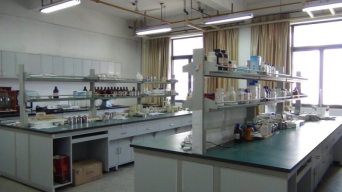
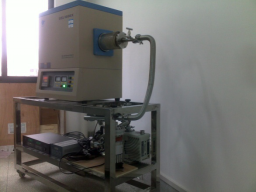
Ceramics preparation lab. Vacuum tube furnace
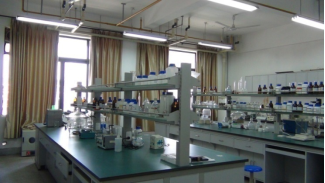
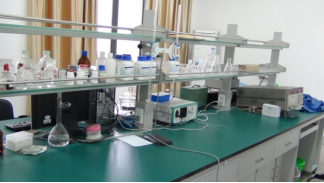
Chemical preparation lab. Electrochemical workstations
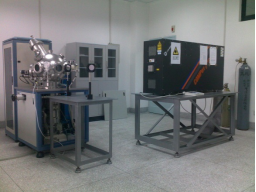
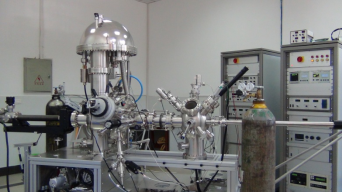
Pulsed laser deposition UHV-XPS, STM, LEED
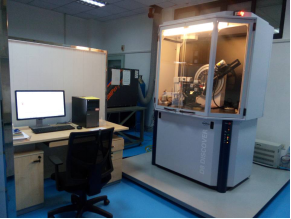
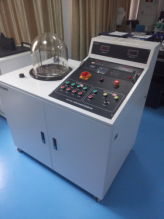
HR-XRD Vacuum evaporator
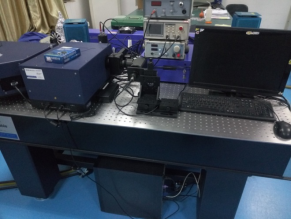
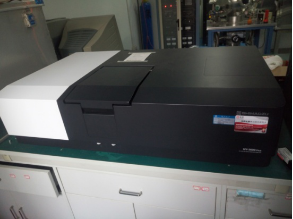
Photoelectric conversion efficiency, PL, IPCE UV-Vis-NIR spectrophotometer
Group photos
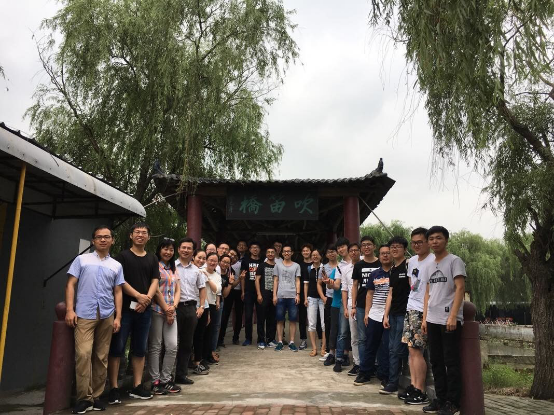
2017 at Eastern Lake, Wuhan
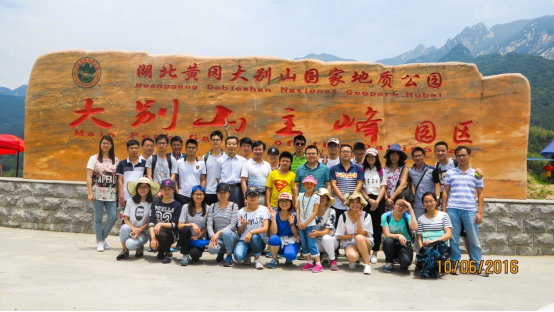
2016 at Tian Tang Zhai, Luo Tian
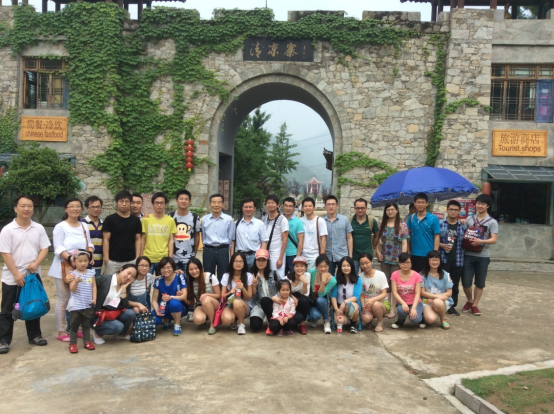
2015 at Qing Liang Zhai, Huang Pi
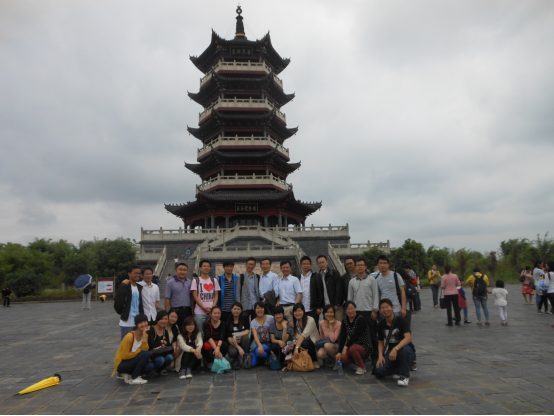
2013 at Nong Geng Nian Hua, Huang Pi
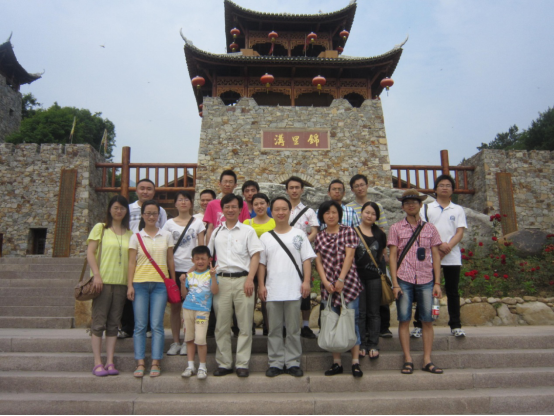
2012 at Jin Li Gou, Huang Pi
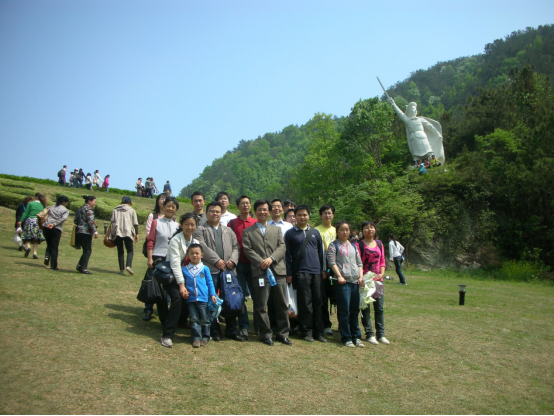
2011 at Mu Lan Tian Chi, Huang Pi

